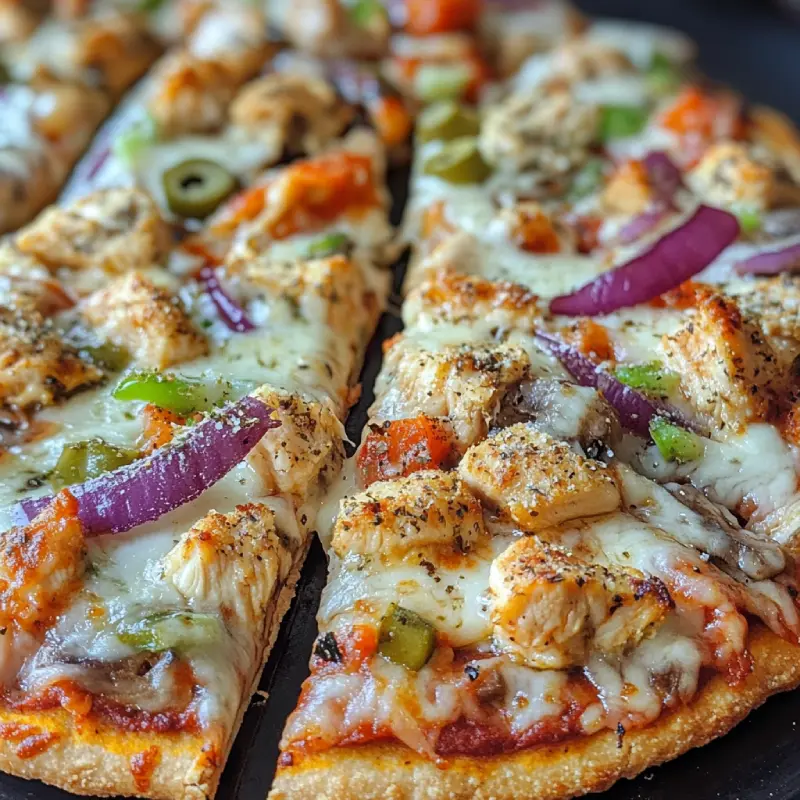Introduction to Chicken Crust Pizza
What is Chicken Crust Pizza?
Chicken crust pizza is a creative and health-conscious alternative to traditional pizza bases, known for its low-carb and high-protein content. This type of pizza swaps the usual dough for a crust made primarily from ground chicken, making it a popular choice among those following keto, gluten-free, or other low-carbohydrate diets. The crust typically includes a mix of ground chicken with seasonings and a binding agent like cheese or eggs to keep it together during baking. Its rise in popularity is largely due to its ability to satisfy pizza cravings without the guilt associated with more carb-heavy meals.
Origins and Evolution
The concept of chicken crust pizza originated from the need to create pizza options that were compatible with dietary restrictions, particularly for those on a ketogenic diet. It represents a shift from traditional culinary practices, offering a nutritious alternative that aligns with modern dietary trends. Initially adopted by home cooks experimenting with keto recipes, the idea quickly gained traction and spread across various culinary blogs and keto community forums. Over time, this innovative pizza base has evolved with variations that include different types of cheeses, herbs, and toppings, each adapting the recipe to suit a range of palates and dietary needs.
Making Chicken Crust Pizza
Basic Ingredients and Preparation
Creating a chicken crust pizza involves a straightforward combination of ground chicken, cheese, and seasonings. Here’s a step-by-step guide to preparing the crust:
- Ingredients:
- Ground chicken: Typically, 1 pound is used to form a standard-sized pizza base.
- Binding agents: A combination of cheeses (such as mozzarella or parmesan) and optionally, an egg to help bind the mixture together.
- Seasonings: Common choices include salt, pepper, garlic powder, and Italian seasoning for a flavor boost.
- Preparation Steps:
- Mix Ingredients: Combine the ground chicken with your chosen cheeses and seasonings in a mixing bowl. If you’re using an egg, whisk it separately before adding to ensure even distribution.
- Form the Crust: Transfer the chicken mixture onto a lined baking sheet or pizza stone. Press it down into a thin layer, shaping it into a circular or rectangular pizza base.
- Pre-Bake the Crust: Bake the crust in a preheated oven (usually around 400°F) for 15-20 minutes or until it starts to turn golden and firm up. This step is crucial to achieving a crust that can hold toppings without getting soggy.
- Add Toppings and Final Bake:
- After pre-baking, add a light layer of your favorite pizza sauce, more cheese, and other toppings like vegetables or additional proteins.
- Bake for another 10-15 minutes until the cheese is bubbly and the toppings are cooked.
This method ensures a crispy and sturdy base that’s both tasty and adheres to low-carb dietary preferences.
Variations of Chicken Crust Pizza
Chicken crust pizza is highly adaptable. Here are some variations to spice up the basic recipe:
- Cheese Variations: Swap mozzarella for sharper cheeses like cheddar or a mix of Italian cheeses for deeper flavor.
- Using Canned Chicken: For a quicker prep time, canned chicken can be a convenient alternative. Ensure it’s thoroughly drained and dried to prevent a soggy crust.
- Seasoning Mixes: Experiment with different herb and spice combinations, such as Cajun spices for a kick or a sprinkle of crushed red pepper for some heat.
- Alternative Diets: For dairy-free versions, omit cheese and use egg as the primary binding agent, or explore vegan cheese substitutes that melt well.
Each variation can transform the basic chicken crust into a new and exciting dish that caters to various tastes and dietary needs.
Nutritional Benefits
Health Benefits
Opting for a chicken crust pizza offers several health benefits, particularly for those following specific dietary plans:
- Low Carb and Keto Friendly: Chicken crust is naturally low in carbohydrates, making it an excellent choice for keto dieters or anyone reducing their carb intake.
- High Protein: Ground chicken provides a high-protein base for the pizza, which is beneficial for muscle repair and overall health. Protein also helps in feeling full longer, which can aid in weight management.
- Gluten-Free: For those with gluten sensitivities or celiac disease, chicken crust is a gluten-free alternative that eliminates the risk of inflammation and digestive issues associated with gluten.
This crust type supports various dietary needs without sacrificing flavor, offering a nutritious foundation for your favorite pizza toppings.
Comparative Analysis with Traditional Crusts
When compared to traditional wheat-based pizza crusts, chicken crust pizza stands out primarily due to its lower carbohydrate content and higher protein levels:
- Carbohydrates: Traditional pizza crusts, typically made from wheat, are high in carbs which can be unsuitable for keto, low-carb, or diabetic diets. In contrast, a chicken crust contains minimal carbs.
- Protein: Chicken crusts significantly increase the protein content of your meal compared to standard wheat crusts, making them more satiating and nutritionally beneficial.
- Caloric Intake: Depending on the toppings used, chicken crust pizza can also be lower in calories. This is due to the absence of high-calorie flours and sugars found in traditional dough.
These nutritional differences make chicken crust an appealing option for health-conscious individuals or those with specific dietary restrictions.
Culinary Techniques and Tips
Cooking Techniques
Achieving a crispy and flavorful chicken crust pizza involves specific techniques to avoid common pitfalls like sogginess. Here are some tips to ensure optimal results:
- Ensure Dryness: Start by ensuring your ground chicken is as dry as possible. Pat it down with paper towels to remove excess moisture which helps in achieving a crispier base.
- Pre-bake the Crust: Before adding any toppings, pre-bake the crust alone to start the crisping process. This step is crucial to prevent sogginess once toppings are added.
- Thin and Even Spread: Spread the chicken mixture thinly and evenly across the baking sheet or pizza stone to ensure uniform cooking and crispiness.
- High Heat: Bake the crust at a high temperature. This helps to quickly seal in the flavors and textures, creating a firm base that can support various toppings without becoming soggy.
- Cooling Before Topping: Allow the pre-baked crust to cool slightly before adding sauce and toppings. This helps prevent steam from the toppings from making the crust soggy.
By following these techniques, you can enhance the texture and flavor of your chicken crust pizza.
Topping Recommendations
Choosing the right toppings can significantly enhance the unique flavor profile of chicken crust pizza. Here are some suggestions:
- Sauces: Opt for light sauces to avoid sogginess. A thin layer of classic tomato sauce, pesto, or even a light white garlic sauce works well with the mild flavor of the chicken crust.
- Cheeses: A mix of mozzarella for stretchiness and a sharper cheese like parmesan or aged cheddar can add depth to the pizza’s flavor.
- Proteins: Since the crust is already protein-rich, consider lighter options like pepperoni, cooked bacon bits, or even a scattering of cooked seafood like shrimp.
- Vegetables: Add color and crunch with vegetables such as bell peppers, onions, spinach, or arugula added after baking to maintain their texture and flavor.
- Finishing Touches: After baking, finishing touches like a drizzle of olive oil, a sprinkle of fresh basil or crushed red pepper can enhance the overall taste and presentation.
FAQs
Frequently Asked Questions
When it comes to preparing, storing, and reheating chicken crust pizza, several questions commonly arise. Here are the answers to some of the most frequent queries:
- How should I store leftover chicken crust pizza?
- Leftover chicken crust pizza should be stored in an airtight container in the refrigerator. It’s best to consume it within 2-3 days to enjoy its optimal freshness and flavor.
- Can chicken crust pizza be frozen?
- Yes, you can freeze chicken crust pizza. For best results, bake the crust without toppings, let it cool, and then freeze it wrapped tightly in plastic wrap and foil. This method helps maintain the texture and flavor when you’re ready to eat it. Simply add toppings and reheat for a quick meal.
- What is the best way to reheat chicken crust pizza?
- To reheat, place the pizza in a preheated oven at 375°F until it is hot and the cheese is bubbly. This method helps to keep the crust crispy. Alternatively, for a quicker option, you can microwave slices on a microwave-safe plate, but be aware this may soften the crust.
- Can I make chicken crust pizza ahead of time?
- For events or quick meals, you can prepare the chicken crust ahead of time and pre-bake it. Store the pre-baked crust in your refrigerator or freezer, and simply add toppings and bake when you’re ready to serve. This is an excellent time-saver for hosting or meal planning.
Conclusion
Chicken crust pizza stands out as a versatile, health-conscious alternative to traditional pizza bases, providing a delicious solution for those following keto, low-carb, or gluten-free diets. Its rise in popularity is testament to its appeal as a nutritious and satisfying meal option that doesn’t compromise on flavor.
- Versatile Culinary Creation: Chicken crust pizza allows for creativity in the kitchen, offering a base that can be topped with a variety of sauces, cheeses, and toppings to suit any taste.
- Dietary Friendly: It meets the needs of various dietary restrictions, offering a high-protein, low-carb alternative that fits well into many health-focused diets.
- Convenient and Customizable: Ideal for meal planning and entertaining, it can be prepared ahead of time, customized to individual preferences, and quickly assembled, making it as convenient as it is tasty.
As more people seek healthier alternatives in their diet, chicken crust pizza provides a satisfying way to enjoy a beloved dish without the guilt.

